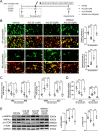Annexin A1 protects against cerebral ischemia-reperfusion injury by modulating microglia/macrophage polarization via FPR2/ALX-dependent AMPK-mTOR pathway
- PMID: 34022892
- PMCID: PMC8140477
- DOI: 10.1186/s12974-021-02174-3
Annexin A1 protects against cerebral ischemia-reperfusion injury by modulating microglia/macrophage polarization via FPR2/ALX-dependent AMPK-mTOR pathway
Abstract
Background: Cerebral ischemia-reperfusion (I/R) injury is a major cause of early complications and unfavorable outcomes after endovascular thrombectomy (EVT) therapy in patients with acute ischemic stroke (AIS). Recent studies indicate that modulating microglia/macrophage polarization and subsequent inflammatory response may be a potential adjunct therapy to recanalization. Annexin A1 (ANXA1) exerts potent anti-inflammatory and pro-resolving properties in models of cerebral I/R injury. However, whether ANXA1 modulates post-I/R-induced microglia/macrophage polarization has not yet been fully elucidated.
Methods: We retrospectively collected blood samples from AIS patients who underwent successful recanalization by EVT and analyzed ANXA1 levels longitudinally before and after EVT and correlation between ANXA1 levels and 3-month clinical outcomes. We also established a C57BL/6J mouse model of transient middle cerebral artery occlusion/reperfusion (tMCAO/R) and an in vitro model of oxygen-glucose deprivation and reoxygenation (OGD/R) in BV2 microglia and HT22 neurons to explore the role of Ac2-26, a pharmacophore N-terminal peptide of ANXA1, in regulating the I/R-induced microglia/macrophage activation and polarization.
Results: The baseline levels of ANXA1 pre-EVT were significantly lower in 23 AIS patients, as compared with those of healthy controls. They were significantly increased to the levels found in controls 2-3 days post-EVT. The increased post-EVT levels of ANXA1 were positively correlated with 3-month clinical outcomes. In the mouse model, we then found that Ac2-26 administered at the start of reperfusion shifted microglia/macrophage polarization toward anti-inflammatory M2-phenotype in ischemic penumbra, thus alleviating blood-brain barrier leakage and neuronal apoptosis and improving outcomes at 3 days post-tMCAO/R. The protection was abrogated when mice received Ac2-26 together with WRW4, which is a specific antagonist of formyl peptide receptor type 2/lipoxin A4 receptor (FPR2/ALX). Furthermore, the interaction between Ac2-26 and FPR2/ALX receptor activated the 5' adenosine monophosphate-activated protein kinase (AMPK) and inhibited the downstream mammalian target of rapamycin (mTOR). These in vivo findings were validated through in vitro experiments.
Conclusions: Ac2-26 modulates microglial/macrophage polarization and alleviates subsequent cerebral inflammation by regulating the FPR2/ALX-dependent AMPK-mTOR pathway. It may be investigated as an adjunct strategy for clinical prevention and treatment of cerebral I/R injury after recanalization. Plasma ANXA1 may be a potential biomarker for outcomes of AIS patients receiving EVT.
Keywords: Annexin A1; Cerebral ischemia-reperfusion injury; Endovascular thrombectomy; Formyl peptide receptor 2; Microglial/macrophage polarization; Neuroinflammation.
Conflict of interest statement
The authors declare no competing interests.
Figures







Similar articles
-
Tat-NTS peptide protects neurons against cerebral ischemia-reperfusion injury via ANXA1 SUMOylation in microglia.Theranostics. 2023 Oct 16;13(15):5561-5583. doi: 10.7150/thno.85390. eCollection 2023. Theranostics. 2023. PMID: 37908731 Free PMC article.
-
Polyphyllin I alleviates neuroinflammation after cerebral ischemia-reperfusion injury via facilitating autophagy-mediated M2 microglial polarization.Mol Med. 2024 May 14;30(1):59. doi: 10.1186/s10020-024-00828-5. Mol Med. 2024. PMID: 38745316 Free PMC article.
-
Annexin-1 Mediates Microglial Activation and Migration via the CK2 Pathway during Oxygen-Glucose Deprivation/Reperfusion.Int J Mol Sci. 2016 Oct 22;17(10):1770. doi: 10.3390/ijms17101770. Int J Mol Sci. 2016. PMID: 27782092 Free PMC article.
-
Loureirin B protects against cerebral ischemia/reperfusion injury through modulating M1/M2 microglial polarization via STAT6 / NF-kappaB signaling pathway.Eur J Pharmacol. 2023 Aug 15;953:175860. doi: 10.1016/j.ejphar.2023.175860. Epub 2023 Jun 16. Eur J Pharmacol. 2023. PMID: 37331681 Review.
-
Therapeutic Potential of Annexin A1 in Ischemia Reperfusion Injury.Int J Mol Sci. 2018 Apr 16;19(4):1211. doi: 10.3390/ijms19041211. Int J Mol Sci. 2018. PMID: 29659553 Free PMC article. Review.
Cited by
-
Specialized Pro-Resolving Mediators in Neuroinflammation: Overview of Studies and Perspectives of Clinical Applications.Molecules. 2022 Jul 28;27(15):4836. doi: 10.3390/molecules27154836. Molecules. 2022. PMID: 35956787 Free PMC article. Review.
-
AnnexinA6: a potential therapeutic target gene for extracellular matrix mineralization.Front Cell Dev Biol. 2023 Sep 4;11:1201200. doi: 10.3389/fcell.2023.1201200. eCollection 2023. Front Cell Dev Biol. 2023. PMID: 37727505 Free PMC article. Review.
-
MK5 Regulates Microglial Activation and Neuroinflammation in Experimental Stroke Models.CNS Neurosci Ther. 2025 Apr;31(4):e70395. doi: 10.1111/cns.70395. CNS Neurosci Ther. 2025. PMID: 40237440 Free PMC article.
-
The Evolution of Ischemia-Reperfusion Injury Research in Ischemic Stroke: Insights From a Two-Decade Bibliometric Analysis.Brain Behav. 2025 Apr;15(4):e70445. doi: 10.1002/brb3.70445. Brain Behav. 2025. PMID: 40165524 Free PMC article.
-
Vitamin D Activates Nrf2 to Prevent Nerve Injury and Reduce Brain Damage in Acute Cerebral Infarction.Curr Med Sci. 2025 Jun;45(3):469-480. doi: 10.1007/s11596-025-00043-1. Epub 2025 May 7. Curr Med Sci. 2025. PMID: 40332737
References
-
- Powers WJ, Rabinstein AA, Ackerson T, Adeoye OM, Bambakidis NC, Becker K, Biller J, Brown M, Demaerschalk BM, Hoh B, Jauch EC, Kidwell CS, Leslie-Mazwi TM, Ovbiagele B, Scott PA, Sheth KN, Southerland AM, Summers DV, Tirschwell DL, on behalf of the American Heart Association Stroke Council Guidelines for the early management of patients with acute ischemic stroke: 2019 update to the 2018 guidelines for the early management of acute ischemic stroke: a guideline for healthcare professionals from the American Heart Association/American Stroke Association. Stroke. 2019;50(12):e344–e418. doi: 10.1161/STR.0000000000000211. - DOI - PubMed
-
- Xu H, Jia B, Huo X, Mo D, Ma N, Gao F, Yang M, Miao Z. Predictors of futile recanalization after endovascular treatment in patients with acute ischemic stroke in a multicenter registry study. J Stroke Cerebrovasc Dis. 2020;29(10):105067. doi: 10.1016/j.jstrokecerebrovasdis.2020.105067. - DOI - PubMed
MeSH terms
Substances
Grants and funding
- 82001317/National Natural Science Foundation of China
- 81801231/National Natural Science Foundation of China
- 81671380/National Natural Science Foundation of China
- 2016YFC1301703/National Key Scientific Instrument and Equipment Development Projects of China (CN)
- D161100003816002/Beijing Science and Technology Planning Project
LinkOut - more resources
Full Text Sources
Other Literature Sources
Research Materials
Miscellaneous

